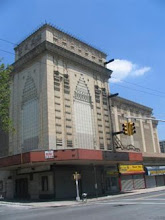Stroll With Me Down Memory Lane -- Pitkin Avenue, April 1945
Life in the Brownsville of my childhood was rough. But it wasn’t all bad – we had Pitkin Avenue.
I was born and raised in the corner building on Herzl and Pitkin, diagonally across from where Shoppers World and the Pitkin Avenue Business Improvement District now live. The buildings along the avenue were not torn down in all the attempts at fixing the disastrous housing conditions that had plagued Brownsville for almost a century.
When the subway and New Lots line were built, it became open sesame for sweat shop workers and their families living in even worse conditions on the lower East Side, and was over 80-90% Jewish. In fact it was a poor neighborhood, and overcrowded. But for most it was really a way station to the hoped-for better life. If many aspects of life in Brownsville were tough, there were others that were very nurturing for kids. I try to describe them in my new book – Brownsville: The Jewish Years.
Key among them was Pitkin Avenue. The store front buildings have not been torn down – but it was a very different place. I invite you to a brief stroll on Pitkin Avenue in the Spring of 1945, just before the war ended. Even then, in the midst of the horrors of a world war, it was a place to dream in. I was just about eleven. Roosevelt had ridden along Pitkin Avenue on a rainy November day during his last Presidential campaign.
Picture this – the air is teasingly warm, it’s April. The place is full of ma and pa shops with the emphasis on fashion. Pitkin Avenue has many expensive shops – my mother and I like to look in the windows even though we can’t afford what’s in them. There was a Rainbow Shops then, but it was so much smaller. There were sportswear shops, hat shops, places that custom-made ladies corsets, you name it.
Any time of day the Avenue was packed with shoppers, baby carriages, street vendors and people getting on and off smelly busses.
Many of the stores actually closed after the summer sales, soaped up their windows and put in signs promising to re-open on or about August 15th. And the owners would go on vacation in the mountains. Imagine that today. And when they did re-open it was to reveal Fall styles and window trim. It was like a fashion show.
There was a lot of ethnic food around – now on Strauss, where a Bootery stands, was Hymie’s delicatessen, which had plump sausages called knockwurst, pickled sliced tongue, pastrami and more. Street vendors sold halvah, sesame candy, sweet potatoes, knishes, hot dogs from carts they pulled along.
Weddings happened on the Avenue. In fact, above Shoppers World was a catering place where Saturday night was wedding night. It was a one-stop deal – the ceremony and the celebration and wedding musicians played both traditional and pop music, complete with vocals, until 2-3 in the morning. And during the hot weather, neighbors would gather on milk crates and old chairs to gossip, argue politics, and when the window was open, enjoy the music until the last notes of “Good Night, Sweetheart.”
There were also men’s clothing shops where a man could have a suit made to order as well as haberdasheries that sold gentlemen’s accessories like ties, men’s jewelry, etc. The most famous was Jack Diamond’s, on Pitkin between Herzl and Strauss, the same building I lived in.
Pitkin Avenue was a destination then. People came from all over Brooklyn, the Bronx, Manhattan, Queens and even Long Island. They parked their cars on the streets where poor people lived in tiny rooms and hardly anyone had phones yet.
But the beacon, the heart of Pitkin Avenue was the Loew’s Pitkin, a magical movie theater on Pitkin, that took up the whole block between Legion and Saratoga. It opened in 1929, showed some of the greatest movies ever made as well as vaudeville – I remember seeing Buck and Bubbles perform LIVE. Here you saw on film families with maids and butlers, high fashion gowns and fur-covered telephones, and came back at night to your hovels. The decor of the theater was also splendid, including the lounges.
We got our news from the movies every week, also from newspaper stands and people’s gossip. Hope for peace was in the air.
Late afternoon on April 12, I was playing with friends in front of Jack Diamond’s window when someone stopped and said, “Have you heard? Roosevelt just died.” It was like my world came to an end – he was gone, the only president I had ever known.
All these memories and so much more are wrapped up for me with Pitkin Avenue and Brownsville.
-Sylvia Seigel Schildt
Brownsville: The Jewish Years is available at Amazon.com.


Thanks for the wonderful post.
ReplyDelete